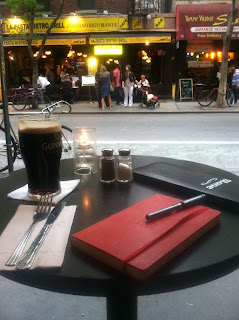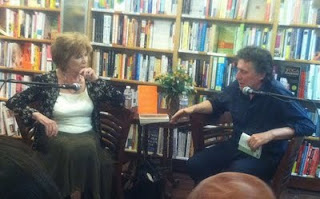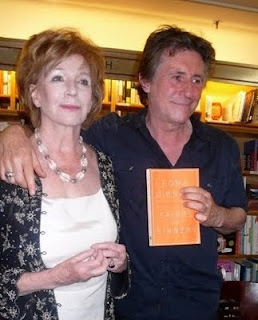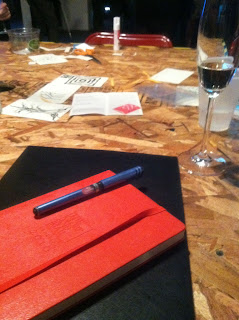Photos from my Flickr photostream.

Photos from my Flickr photostream.
 My writing has changed, and I blame (thank?) McNally Jackson. Without actor Gabriel Byrne liking the bookstore so much, I would’ve never had the chance to meet and chat with one of my literary heroes -and my writing wouldn’t be experiencing the painful if necessary (and deeply overdue) growing pains it is now.
My writing has changed, and I blame (thank?) McNally Jackson. Without actor Gabriel Byrne liking the bookstore so much, I would’ve never had the chance to meet and chat with one of my literary heroes -and my writing wouldn’t be experiencing the painful if necessary (and deeply overdue) growing pains it is now.
 It’s hard for me to verbalize the effect O’Brien’s work has had on me the last few years, particularly her latest work, a collection of short, powerfully moving stories. Her use of langauge is deeply poetic and loudly, proudly recalls some of the best in Irish writing, namely James Joyce and Seamus Heaney, but with the distinctly feminine voice and brisk narrative quality of Clare Boylan. O’Brien is in a class by herself, however. Born in County Clare in 1930, she had, like many of the time, a convent education and, in her conversation with Byrne, spoke dramatically of the limitations and restrictions placed on her and fellow students. There’s a refreshing honesty to both her work and to seeing her read and speak in person. O’Brien is a very theatrical person, and, even in conversation, carefully chooses her words, drawing out vowels and making dramatic pauses, as if she’s delivering the best damn monologue you’ve ever experienced.
It’s hard for me to verbalize the effect O’Brien’s work has had on me the last few years, particularly her latest work, a collection of short, powerfully moving stories. Her use of langauge is deeply poetic and loudly, proudly recalls some of the best in Irish writing, namely James Joyce and Seamus Heaney, but with the distinctly feminine voice and brisk narrative quality of Clare Boylan. O’Brien is in a class by herself, however. Born in County Clare in 1930, she had, like many of the time, a convent education and, in her conversation with Byrne, spoke dramatically of the limitations and restrictions placed on her and fellow students. There’s a refreshing honesty to both her work and to seeing her read and speak in person. O’Brien is a very theatrical person, and, even in conversation, carefully chooses her words, drawing out vowels and making dramatic pauses, as if she’s delivering the best damn monologue you’ve ever experienced. Telling the truth isn’t always easy – especially when it’s sitting there in front of us. Some truths are easier to swallow than others – and once we discover them, it’s up to us how we choose to live with their loud mewlings, awkward quietude, and late-night bawling. Do we pretend they’re not there? Or face that truth square-on? On Monday night, Byrne confessed to her that, back when he was growing up in Ireland, “I read your work to find myself.” The author seemed stunned, caught off guard by such an admission, and responded, carefully and wide-eyed, “You mean to find an identity? a larger sort of identity?” Byrne re-phrased things so as not to put her on the spot, but we all knew what he meant, as he looked at his friend with a mix of awe, admiration, and gratitude.
Telling the truth isn’t always easy – especially when it’s sitting there in front of us. Some truths are easier to swallow than others – and once we discover them, it’s up to us how we choose to live with their loud mewlings, awkward quietude, and late-night bawling. Do we pretend they’re not there? Or face that truth square-on? On Monday night, Byrne confessed to her that, back when he was growing up in Ireland, “I read your work to find myself.” The author seemed stunned, caught off guard by such an admission, and responded, carefully and wide-eyed, “You mean to find an identity? a larger sort of identity?” Byrne re-phrased things so as not to put her on the spot, but we all knew what he meant, as he looked at his friend with a mix of awe, admiration, and gratitude.As I walked around Frank Lloyd Wright’s beautiful white spirals in the Solomon R. Guggenheim museum, I ducked into a special exhibition, Kandinsky At The Bauhaus, and… there it was, in all its orbular glory: Several Circles.
The Guggenheim website offers insight:
“The circle,” claimed Kandinsky, “is the synthesis of the greatest oppositions. It combines the concentric and the eccentric in a single form and in equilibrium. Of the three primary forms, it points most clearly to the fourth dimension.”
In its magnificent, lidless, concentrated, and sensually concentric presence, I sat, mouth agape, staring at its hip-swirling dance of color, form, light, and texture. The fourth dimension indeed. There are few things that take me so directly there as painting and the written word.
 I write, every day, in a real, actual journal, with a real, actual pen. It seems almost quaint. In this world of iPads and iPhones and digitalthisthatandtheother, writing in a journal seems fabulously oldy-world-y, and vaguely old-fashioned. It takes more time to write than type; this forces a stewing of thoughts, a quiet, patient consideration and re-consideration, one that ultimately transforms expressions and observations and perceptions into stained, messy, occasionally wine-spilled musings that melt, all over the pages, like soft, salt-water taffy slowly expiring on the tongue. ‘Do I like how this looks on the page?‘ becomes every bit as important as, ‘What am I trying to say again?’ and I’m often surprised at how much I miss my journal the times when I go out and forget it. I don’t always use it; it’s more an observational talisman that makes me look at things -and smell them, taste them, hear them, feel them – a little more closely.
I write, every day, in a real, actual journal, with a real, actual pen. It seems almost quaint. In this world of iPads and iPhones and digitalthisthatandtheother, writing in a journal seems fabulously oldy-world-y, and vaguely old-fashioned. It takes more time to write than type; this forces a stewing of thoughts, a quiet, patient consideration and re-consideration, one that ultimately transforms expressions and observations and perceptions into stained, messy, occasionally wine-spilled musings that melt, all over the pages, like soft, salt-water taffy slowly expiring on the tongue. ‘Do I like how this looks on the page?‘ becomes every bit as important as, ‘What am I trying to say again?’ and I’m often surprised at how much I miss my journal the times when I go out and forget it. I don’t always use it; it’s more an observational talisman that makes me look at things -and smell them, taste them, hear them, feel them – a little more closely. So I was delighted to attend an event celebrating the tactile -recently. Called “Objectivity”, the event was held at Eyebeam, a digital art space on the west side of Manhattan. The event was part of A vocabulary of objects, a formal Moleskine event that saw workshop participants make their very own journals. On one side of the sprawling warehouse space, a massive piece of paper had been tacked onto a broad wall that dominated one side of the room. It had a mottled projection across it; black drafting pencils had been set out to encourage attendees to add their own markings. People were riotously, joyously drawing as they balanced glasses of prosecco and chatted. I added to the markings with a few wild lilies. I didn’t see one person texting or talking on a phone – only drawing, drinking, watching, creating, and connecting.
So I was delighted to attend an event celebrating the tactile -recently. Called “Objectivity”, the event was held at Eyebeam, a digital art space on the west side of Manhattan. The event was part of A vocabulary of objects, a formal Moleskine event that saw workshop participants make their very own journals. On one side of the sprawling warehouse space, a massive piece of paper had been tacked onto a broad wall that dominated one side of the room. It had a mottled projection across it; black drafting pencils had been set out to encourage attendees to add their own markings. People were riotously, joyously drawing as they balanced glasses of prosecco and chatted. I added to the markings with a few wild lilies. I didn’t see one person texting or talking on a phone – only drawing, drinking, watching, creating, and connecting. And so, the Moleskin event At Eyebeam was a bit of heaven, here and now in New York City, 2011, amidst the hub-bub of technology and the joy of digital connectivity. Those have a place. So do the tangible arts. Being able to draw with total strangers felt like a strong reaffirmation of the vital role of the tangible in everyday life. Even as we ostensibly move further away from experiencing daily life with our five senses, at the same time, we move closer to it, taking pensive, tip-toe steps into that “fourth dimension” Kandinsky referred to. Can we make it? Can we commit? I freely admit to being addicted to the bonbons of modern life: Facebook, Twitter, Flickr, Soundcloud, Linked In … blogging. But I’m circling back to sensuality, being reminded, in tiny spiraling whispers, that I never left. That fourth dimension is beckoning me, to enter, and re-enter, again and again. I want to keep walking, I’m curious what I’ll find in the middle, on the outer rings, and along the way. Stained fingers? That…and a whole lot more.
And so, the Moleskin event At Eyebeam was a bit of heaven, here and now in New York City, 2011, amidst the hub-bub of technology and the joy of digital connectivity. Those have a place. So do the tangible arts. Being able to draw with total strangers felt like a strong reaffirmation of the vital role of the tangible in everyday life. Even as we ostensibly move further away from experiencing daily life with our five senses, at the same time, we move closer to it, taking pensive, tip-toe steps into that “fourth dimension” Kandinsky referred to. Can we make it? Can we commit? I freely admit to being addicted to the bonbons of modern life: Facebook, Twitter, Flickr, Soundcloud, Linked In … blogging. But I’m circling back to sensuality, being reminded, in tiny spiraling whispers, that I never left. That fourth dimension is beckoning me, to enter, and re-enter, again and again. I want to keep walking, I’m curious what I’ll find in the middle, on the outer rings, and along the way. Stained fingers? That…and a whole lot more.Powered by WordPress & Theme by Anders Norén